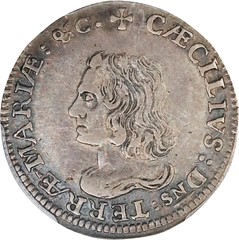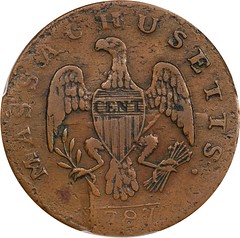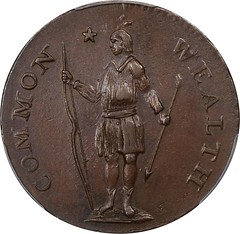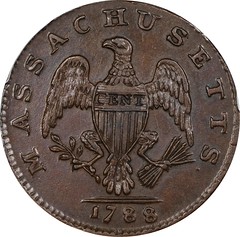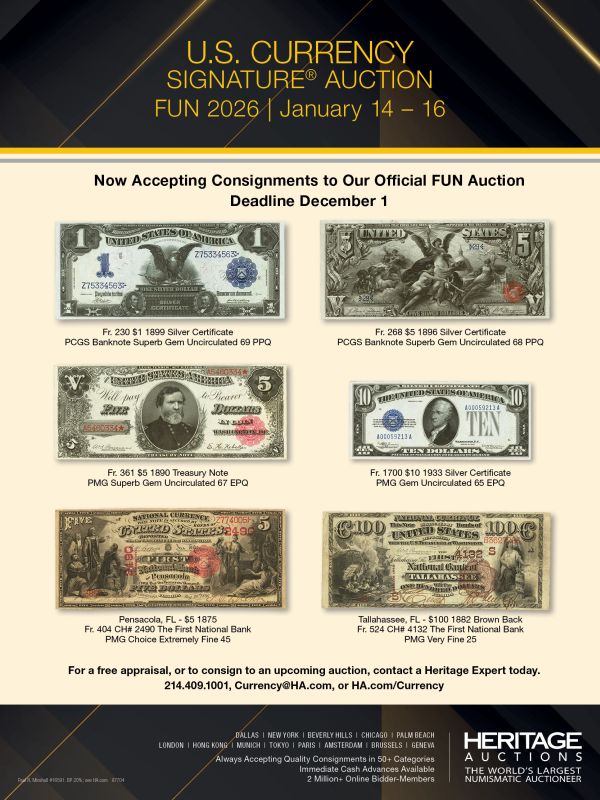
PREV ARTICLE
NEXT ARTICLE
FULL ISSUE
PREV FULL ISSUE
STACK'S BOWERS: RICHARD AUGUST COLLECTIONStack's Bowers will be selling the Richard August Collection on November 10. Select Colonial & Early American Highlights are discussed below. -Garrett
1652 Pine Tree Shilling. Large Planchet. Noe-1, Salmon 1-A, W-690. Rarity-2. Pellets at Trunk. AU-55 (PCGS). The iconic Noe-1 Pine Tree shilling is regarded as the quintessential type coin in the Massachusetts Bay Colony silver series. These pieces were the first struck for those British colonies that would eventually become part of the United States. They are also among the few American colonial issues struck in silver. Produced to an uncommonly high standard of quality, and relatively plentiful by Massachusetts silver standards, the Noe-1 Pine Tree is a perennial favorite among both colonial type collectors and series specialists. This is an attractive and inviting specimen at the Choice AU grade level that is worthy of strong bids.
To read the complete item description, see:
Undated (1659) Lord Baltimore Sixpence. Hodder 2-C, W-1060. Rarity-5. Small Bust, No Stop. Silver. EF-45 (PCGS). Choice and original Lord Baltimore sixpence such as this are highly elusive, a fact that the discovery of 19 pieces in a single English hoard in 2002 did little to change. Few of those pieces showed this kind of strike, most were wiped or cleaned, and none showed this sort of richly original toning. At least one example of this type has been recovered in the ground in North America (in southern Virginia), and many are well circulated, definitive proof that this type achieved its purpose of colonial American circulation in the 17th century. Purchased from Anthony Terranova.
To read the complete item description, see:
1722 Wood's Hibernia Farthing. Martin 1.1-A.1, W-12200. Rarity-5. D: G: REX, Harp Left. MS-65 BN (PCGS). Syd Martin's 2007 census, published in his reference The Hibernia Coinage of William Wood (1722-1724), lists only eight examples of this die pairing traced in major collections, including the Norweb-August coin offered here. We have handled a total of six in Mint State: this one; the spectacular Ted L. Craige specimen in PCGS MS-65 BN that brought $21,150 in our March 2013 Baltimore Auction; the Robison-Archangel coin in PCGS MS-63 BN that realized $19,200 in our October 2018 Baltimore Auction; and the two Ford VII coins from our (Stack's) January 2005 sale, one cataloged as "Gem Uncirculated, Prooflike," the other as "Uncirculated, or slightly finer." The Roper-E Pluribus Unum coin is also technically Mint State, but was certified Unc Details--Tooled by PCGS when offered in our November 2020 sale of the latter collection. The Archangel cataloger described the Craige specimen as "probably finest known," but the Norweb-August specimen is also a strong contender for that coveted title. In any event this is a landmark example of a celebrated type. It is a highlight of the Wood's coinage in Mr. August's collection, and will be a highlight in the next cabinet in which it is included. Norweb Collection, Part III, Bowers and Merena's, November 1988, lot 3422.
To read the complete item description, see:
1785 Nova Constellatio Copper. Crosby 3-B, W-1895. Rarity-2. CONSTELLATIO, Pointed Rays, Large Date. MS-65 BN (PCGS). 108.2 grains. Extraordinary quality and eye appeal for the type, issue, and die pairing, this is the finest certified 1785 Crosby 3-B that has come to auction. Syd Martin's is a PCGS MS-63 BN, Eric Newman's (sold by Heritage) was certified MS-64 BN by NGC, and so on. ex L. Charney.
To read the complete item description, see:
1787 Massachusetts Cent. Ryder 5-I, W-6130. Rarity-7+. Stout Indian, Arrows In Left Talon. Fine-15 (PCGS). There is not a collection of state coppers that exists today, or at any point in the past, that would not have been improved by this coin. Its status as a Machin's Mills production ties it into a manufactory whose history is relevant to collectors of Connecticut and New Jersey coppers, in addition to the counterfeit halfpence and elusive patterns struck in the shack on Orange Pond. Gary Trudgen suggests in "So-Called Counterfeit Massachusetts Cents" (C4 Newsletter, Summer 2024) that this die marriage and its brethren may have been patterns struck for a coining proposal rather than purely profit-motivated counterfeits. That idea makes a great deal of sense for Ryder 7-H, whose survivors often show impressively smooth edges and whose census includes a number of high grade survivors. For this variety, it strikes us as unlikely, though not impossible. This obverse is also numbered as Ryder's Obverse 14, a 1788-dated counterfeit that couldn't have been a pattern. We suspect this variety and that one were struck at essentially the same time, and that the 1788-dated reverse was made after this one failed early from its fatal cracks. There may be no more interesting issue in this entire series. The 1787 Ryder 5-I is a rarity without compare, one that deserves to stand with the most distinctive trophies of the other state copper series. This example, though known for decades, does not appear to have ever sold publicly before now. James Kelly.
To read the complete item description, see:
1788 Massachusetts Cent. Ryder 17-I, W-6420. Rarity-7-. Bowed Head, Period After MASSACHUSETTS. AU-58 (PCGS). 151.8 grains. The finest known example by nearly 40 points, a legendary survivor of this extraordinary rarity. This piece has been well known to Massachusetts copper specialists for decades, but this is its very first auction appearance. Discovered in 1960 by Phil Greco, only eight additional examples of this variety have been discovered since the initial publication of the die marriage 65 years ago. There isn't a single other example better than VF, and most are barely Fine. According to the Whitman Encyclopedia (2009), "Mike Packard records seven known. The finest is the Mint State [coin] in the Richard August collection." In Packard's most recent accounting, there are 10 known specimens, but this one remains at the top of the list with no close competitors.
To read the complete item description, see:
1787 Excelsior Copper. W-5785. Rarity-6. Eagle on Globe Facing Left. EF-40 (PCGS). 132.7 grains. With the Articles of Confederation reserving coinage rights for the individual states, in early 1787 several petitions reached the Legislature in New York seeking approval to issue copper coins. In the end, however, the New York Legislature decided against authorizing a new coinage and instead opted to regulate the copper coins already in circulation. Even so, several unauthorized copper issues made their appearance in the state, primarily from the private mint known as Machin's Mills, located at the outlet of Orange Pond near Newburgh, and those enterprises operated by John Bailey and Ephraim Brasher in and near New York City. The Nova Eborac and Excelsior pieces are attributed to Bailey and Brasher, although beyond that little is known either of their overall coinage operations or the specifics of these issues. The Excelsior pieces are far rarer than their Nova Eborac counterparts. There are three basic varieties of the former type, combining an obverse with the New York Arms and the word EXCELSIOR with a Heraldic Eagle reverse. One of those varieties shows a Heraldic Eagle with the arrows in the talon at left, the so-called Transposed Arrows reverse, W-5775. The other two use the same Heraldic Eagle dies but two different New York Arms dies, one showing the tiny eagle atop the shield facing to the left, as seen here, and the other showing that tiny eagle facing to the right (W-5780, offered above). The Transposed Arrows variety is the rarest, with just six known. This is the more common of the two others, although we caution bidders that most survivors of the W-5785 in numismatic hands are in low grades, and often with significant impairments. Indeed, our typical offering for this type is in the Fine to VF grade range, with surface and environmental damage topping the list among problems to expect. Richard August's discerning eye clearly recognized the rarity of such smooth, problem-free surfaces as seen here which, when combined with above average definition, makes for a coin that would be difficult to improve upon for the collector seeking a single Excelsior copper for type purposes, or the specialist who desires a superior example of the W-5785 type. We have offered only one sharper example in recent years, the PCGS AU-50 in our March 2017 sale of the Anthony Bettancourt Collection. Yet while that piece retained more definition than seen here, it also carried several noticeable marks, including a number of nicks at central reverse and an unfortunate scrape on the obverse through the first letter E in EXCELSIOR; both examples are struck similarly off center to upper left. We find the Richard August specimen more pleasing and overall finer, and are confident that knowledgeable bidders will agree.
To read the complete item description, see:
1786 New Jersey Copper. Maris 24-R, W-4975. Rarity-5. Curved Plow Beam, Narrow Shield. MS-63 BN (PCGS). 149.6 grains. This is one of the two finest survivors of this die marriage, listed as finest known in the 2013 SHI census but listed as one of two UNC coins in the 2024 version. The other Mint State coin is in the Anton Collection; the image in the 2024 SHI update looks comparable to this one in overall quality. The census drops starkly following the top two, as coins 3 through 9 on the 2024 census are all graded either VF+ or VF. This is a genuinely rare variety in all grades, but essentially non-collectible better than Very Fine. The Siboni, Howes, Ish reference notes that John Griffee counted 38 of these in his 1990s series on New Jersey varieties but "it is likely that Griffee's method overstates the number of specimens known." A typical specimen is perhaps in the Fine range, often with surface problems. This one is quite substantially better. Earlier apparently from our (Stack's) sale of the Davis-Graves Collection, April 1954, lot 54.
To read the complete item description, see:
1787 New Jersey Copper. Maris 73.5-jj, W-5435. Rarity-8+. Sprig Above Plow. Struck over a Connecticut Copper. VG-10 (PCGS). 121.8 grains. We are honored to have the opportunity to offer this variety at auction for the very first time since its discovery nearly 50 years ago. It stands out among the New Jersey rarities for its eye appeal and grade, for its use of two dies seen nowhere else, and for its similarity to the popular Maris Obverse 73. This is the centerpiece of the Richard August Collection of New Jersey Coppers and will be the centerpiece of whatever advanced cabinet becomes its new home. There are only 14 unique varieties in the New Jersey series: Maris 4 1/2 - pp, Maris 5-C, Maris 7-C, Maris 10-oo, Maris 10 1/2 - C, Maris 11-G, Maris 11-hh, Maris 26-d, Maris 38-L, Maris 59-mm, Maris 62 1/2-r, Maris 73 1/2 - jj, Maris 80-ff, and Maris 81-ll. Aside from the two circulating counterfeits at the end of that list and the New Jersey Non Vi Virtute Vici (Maris 4 1/2 - pp), each of these uses at least one previously known die, and several are unique mulings of two dies used elsewhere. This coin stands alone as the only non-counterfeit horsehead to employ two dies that saw use in no other New Jersey die marriage. For collectors who seek to add not only as many varieties, but to represent as many dies as possible, this is meaningful and adds particular value to this piece. This piece was featured on the cover of the C4 Newsletter's issue of Spring 2001 and described in an article therein by Mr. August and Dennis Wierzba, where Dick described how this coin was found: "At the time of the Garrett sale, Richard August was able to visit a number of local NYC coin shops prior to the auction. As luck (and persistence) would have it, he was able to uncover and purchase an unlisted NJ variety. Richard Picker verified the new discovery and immediately tried to purchase it. No sale, as the coin still resides in the August Collection." This was Dick's modus operandi for decades: patiently mining coin shops and small shows, putting in the work tirelessly, and finding that the more he dug, the better luck he had. Undoubtedly Dick knew immediately that he had found something new and special, though at first glance it could be confused for a Maris 73-aa. Like that variety, from whom it earned the Maris 73 1/2 designation, this piece is overstruck. Interestingly, the Connecticut copper that served as its host was double struck: the primary date of the Connecticut undertype is readily seen at 9 o'clock on the New Jersey obverse, but directly above the 8 of that date is another 7 from a second Connecticut strike. Another floating 8 is seen above the New Jersey date, just above the base of the plow; this looks like the same style 8 as the New Jersey dies, which means both the host and the overstrike are double struck. The position of the quatrefoil against the top of the Connecticut portrait, seen near the base of the New Jersey reverse, permits ready identification of the undertype as Miler 18-g.1. The use of a double-struck Connecticut as a host limited the amount of detail this coin would have showed even when new. A star and CAESAREA are complete across the top of the obverse. Only a few obverse dies show a star between NOVA and CAESAREA, including 66, 67, 69, 72, 74, and 76, and the resemblance here to the style of Obverse 72 and the horsehead styles of 74 and 76 are unavoidable. The squared snout looks like Obverses 72 and 73, while the curved ear in profile looks a lot like 75. The horsehead device and the scroll below are visible and essentially complete. The plowshare and plowbar are mostly present, the coulter is complete, and a hint of the singletree is visible. A five-pointed star like the one between NOVA and CAESAREA appears at the end of the legend. Denticles are seen at top and right. The areas that show no design -- behind the head, at the plowhandles, and elsewhere -- are likely from the contorted shape and wear pattern of the double struck host. They are not the result of damage. On the reverse, URIBUS U is bold, with a five-pointed star separating the words. The tops of E PL, with a similar star in between, are also seen. The point of the shield is plain, as are the tiny sprigs below. An arc of denticles appears the base of the reverse. The central reverse is featureless, showing the outline of the back of the head from the Connecticut portrait but little else, a conspiracy of strike, the topography of the host, and perhaps a failed die as well.
To read the complete item description, see:
1787 Vermont Copper. RR-32, Bressett 12-K, W-2115. Rarity-7+. Bust Right. Overstruck on a Nova Constellatio Copper. VF-25 (PCGS). 119.2 grains. A remarkable and enduring rarity among Vermont coppers and the first number added to the series after Ryder's 1919 attribution guide. Ryder himself knew of the variety in his lifetime, having acquired the 1921 Whipple Sale coin, but since that achievement came after publication of his attribution guide, the unusually high RR number for a 1787-dated variety, sequenced with the 1788s in fact, is easily understood. As Ryder explained when he released his corrections and additions list in 1921 (quoted in Carlotto): A specimen from the Whipple Collection was sold by Mr. Elder, Feb. 23, 1921. Had this variety been known when the list of Vermont coins was compiled, it would have been listed as No. 13, advancing all subsequent numbers. When Tony Carlotto's outstanding reference The Copper Coins of Vermont was published in 1993, the census for RR-32 stood at just four coins. Since then one other example has been confirmed, but although the current roster has nudged up to five specimens, this is functionally a Rarity-8- rather than a Rarity-7+ variety, as two examples are impounded in institutional collections. he plate coin for the variety in The Copper Coins of Vermont by Tony Carlotto, 1993, p. 168.
To read the complete item description, see:
1788 Vermont Copper. RR-33, Bressett 21-Y, W-2210. Rarity-7+. Bust Right. Overstruck on a 1782 Irish Halfpenny. Fine Details--Cleaned (PCGS). 120.1 grains. Superlatives are everywhere in numismatics: first, finest, biggest, rarest, most valuable. But few coins can claim to be the finest known example of the rarest variety in one of the most popular series in early American numismatics. There is no rarer Vermont copper variety. Only three examples are known, just two of which are still privately owned. Since the discovery of this variety in 1942, this is only the third auction appearance of the die marriage. In eight decades of hunting out and attributing Vermont coppers, no finer example has ever been located, and this specimen has never before been sold at auction. This piece, despite its perhaps unimpressive grade assignment, is the finest known example by a significant margin, displaying design elements seen on neither of the other two survivors. This is the only example with a date. More of the legends and devices are visible here than on the others, despite the prominence of the 1782 Irish halfpenny host. The only example of this variety that has ever sold at public auction is the discovery coin, long in the Vermont copper collection of Q. David Bowers that was acquired intact by Don Partrick. It sold in the 2015 Partrick sale at $42,300 to Syd Martin, then sold in our August 2023 Syd Martin sale for $108,000. A well balanced VG-8 (NGC), it too is overstruck on an Irish halfpenny. It's easily the second finest known, as the Bennington Museum example is included on the Roy Bonjour census as "Good / About Good" and was described by Jeff Rock in CNL-102 as "just enough detail left to attribute with certainty ... an ugly coin but a rare variety." Every Vermont collector on the planet but one lacks this variety. Every Vermont collection on the planet would be improved with the addition of this coin, via upgrade or by the addition of an extremely rare variety. All the classic cabinets through history whose names are uttered in hushed tones, from Ryder and Boyd to Hinkley and Norweb and Ford, would have been improved by this coin. It is a classic, a landmark, and the highlight of the Richard August Collection of Vermont Coppers.
To read the complete item description, see:
Wayne Homren, Editor The Numismatic Bibliomania Society is a non-profit organization promoting numismatic literature. See our web site at coinbooks.org. To submit items for publication in The E-Sylum, write to the Editor at this address: whomren@gmail.com To subscribe go to: Subscribe All Rights Reserved. NBS Home Page Contact the NBS webmaster 
|


